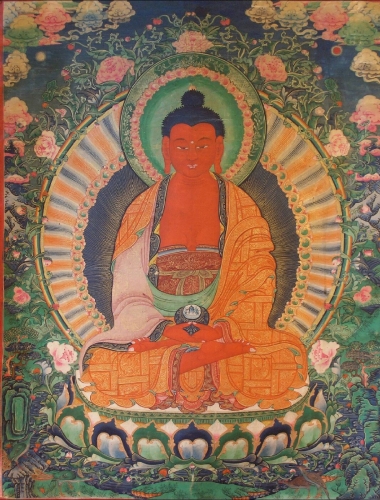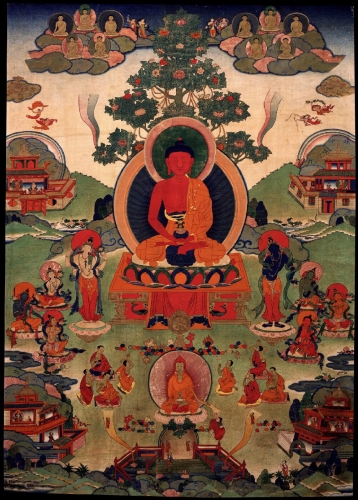Buddhist practice and Buddhist art have been inseparable in the Himalayas ever since Buddhism arrived to the region in the eighth century. But for the casual observer it can be difficult to make sense of the complex iconography. Not to worry—Himalayan art scholar Jeff Watt is here to help. In this “Himalayan Buddhist Art 101” series, Jeff is making sense of this rich artistic tradition by presenting weekly images from the Himalayan Art Resources archives and explaining their roles in the Buddhist tradition.
This week Jeff explains the appearance and iconography of Amitabha Buddha in Himalayan Buddhist art.
Himalayan Art 101: Amitabha Buddha
 In the Theravada teachings of Buddhism there is really only one Buddha that is being discussed: the historical Shakyamuni Buddha. However, in Mahayana Buddhism the cast of primary characters increases. A number of new buddhas are introduced, of which Amitabha is one of the most popular and well known.
In the Theravada teachings of Buddhism there is really only one Buddha that is being discussed: the historical Shakyamuni Buddha. However, in Mahayana Buddhism the cast of primary characters increases. A number of new buddhas are introduced, of which Amitabha is one of the most popular and well known.
Amitabha appears slightly different from Shakyamuni Buddha, and, notably, appears in a different geography. He looks similar to the Buddha with the typical ushnisha on the crown of his head, red skin, peculiar blue hair, long earlobes, three horizontal lines on the neck, right arm bare, wearing the robes of a monastic while seated in vajra posture. He always has his two hands placed in his lap in a gesture of meditation, often holding a black or dark blue begging bowl.
Amitabha does not reside on the southern continent, the location where Shakyamuni reached enlightenment, but in the West at a location called Sukhavati, often referred to in Western literature as the Western Paradise, the Pure Land of Amitabha, or the Heaven of Bliss. The characteristics of Sukhavati are clearly described in the sutra along with the requirements necessary for taking rebirth in this Western Paradise.
In painting, Amitabha is often depicted as a single figure, such as in the first example. By the imagination of the artist, the monastic robes are often transformed into something quite opulent and otherworldly, conveying the very finest in textiles and brocades. Also popular are depictions of Amitabha in front of a great wish-fulfilling tree, atop a peacock supported throne, and at the center of the Western Paradise. Most often, accompanying him at the sides and in front are the eight great bodhisattvas of the Mahayana Buddhist tradition, including Avalokiteshvara, Vajrapani, Maitreya, and Manjushri. Figures of monks representing the arhats and pratyekabuddhas are also present, in addition to flying monks and numerous other buddhas in the sky. Fortunate beings who have the appropriate merit are pictured at the bottom of such compositions, taking birth from the center of pink lotus blossoms.
depicted as a single figure, such as in the first example. By the imagination of the artist, the monastic robes are often transformed into something quite opulent and otherworldly, conveying the very finest in textiles and brocades. Also popular are depictions of Amitabha in front of a great wish-fulfilling tree, atop a peacock supported throne, and at the center of the Western Paradise. Most often, accompanying him at the sides and in front are the eight great bodhisattvas of the Mahayana Buddhist tradition, including Avalokiteshvara, Vajrapani, Maitreya, and Manjushri. Figures of monks representing the arhats and pratyekabuddhas are also present, in addition to flying monks and numerous other buddhas in the sky. Fortunate beings who have the appropriate merit are pictured at the bottom of such compositions, taking birth from the center of pink lotus blossoms.
There are only a few subjects in Himalayan art that portray Mahayana Buddhism specifically. Some examples include paintings and murals of the heavens of Akshobhya and the Medicine Buddha, depictions of the Thirty-Five Confession Buddhas, and the thousand buddhas of this current age. Paintings of Amitabha Buddha and scenes of the heaven of Sukhavati are important and iconic examples drawn directly from the Mahayana sutras.
There are many different Buddhas represented in Buddhist art. Following the historical Buddha Shakyamuni, the next most common buddha form to appear in art is likely Amitabha. His popularity is based in the Mahayana sutra literature, of which there are many texts devoted to him. In artistic depictions, Amitabha has two appearances with two respective names. When referred to as Amitabha (“immeasurable light”), he has the appearance of a standard buddha form, though red in color, wearing the traditional patchwork robes of a monk. In his other appearance he has a different name, Amitayus (“immeasureable life”), and wears the clothing and jeweled adornments of a peaceful, heavenly god, in accordance with the classical Indian system of divine aesthetics.
In the Mahayana tradition, a buddha is described as having three bodies: a form body (nirmanakaya), an apparitional body (sambhogakaya), and an ultimate truth body (dharmakaya). Amitabha and Amitayus are the same person, where the former represents the form body and the latter the apparitional body. The ultimate truth body is without description. The important iconographic difference between the two forms is that Amitabha has a “buddha appearance” and Amitayus a “bodhisattva appearance.”
Learn more about Amitabha Buddha from Himalayan Art Resources here.
Thank you for subscribing to Tricycle! As a nonprofit, we depend on readers like you to keep Buddhist teachings and practices widely available.